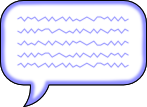Lesson 1
 The Wedge
The Wedge
You can test the wedge by adjusting the length of the wedge. Click on the slider bar below the wedge, then drag it to elongate or shorten the wedge. The width of the wedge will remain the same.
Data Collection::
Table 1: the Wedge
When you have selected a size for the wedge, click on [Add Mass] and blocks will appear on your wedge. Record the length of your test wedge, and the weight applied to separate the stone on Table 1 in your lab packet. Test a variety of sizes until you feel comfortable in predicting what wedge sizes will separate the stone with the least force.

Talk Now
- 1b
Discuss with your partner then write a general statement in your lab packet, explaining which wedges will work most effectively.
Data Analysis 1:
To look at this information in another way, make a line graph in your packet showing the dimensions of the wedges you have tested. Use the second graph to look at the force required for all wedges.
What might happen with the extreme shapes? (almost flat to almost
pin like)
Read and complete these Analysis Questions after completing your graphing in the lab packet, then you will be ready to move on to the Lever activity.
- Using the data from your chart and your graph, write a general statement about the length and width of the wedges that did the work most efficiently.
- Make a prediction of what might happen with extreme shaped wedges. i.e.: an extremely long wedge or a very short, almost-flat wedge. Might there be problems at both extremes? Explain your prediction.
- How did the force which was applied to the wedge change as you changed the length of the wedge?
- What is the relationship between the wedge and the force required to use it?
- Refer back to your prediction at the beginning of this lab How might you change your statement to be more accurate or more complete?



